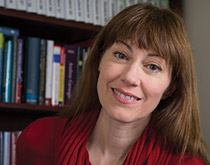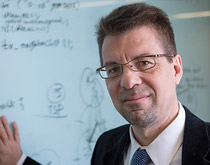A few days earlier, the Carnegie Mellon student turned in his technical writing assignment—a mock editorial on an environmental issue—for an environmental engineering course. Now, he’s reviewing feedback from his professor, sent to him via email.
It’s all part of a novel program in Civil and Environmental Engineering, coordinated by Janel Miller, a retired Alcoa engineering manager. She joined the CMU faculty part-time in 2006 as a CEE instructor, but she—along with other CEE faculty—felt their methodical problem-solvers could use an extra edge. With this program, CEE aims to send its students into the world as effective at communicating their ideas as they are at building them.
For the student who is reviewing his mock editorial, he glances through Miller’s comments and notices something unexpected. Alongside her note “too technical for newspaper readers” of a Web site link. Curious, he clicks.
A video pops up, and a woman with a warm smile fills the screen. Shelves packed with books line the wall behind her. “If you ask a professional engineer the most important thing about effective technical communication,” begins Necia Werner, CMU assistant teaching professor of English, “you’ll probably hear something surprising. It’s not your knowledge of the density of steel or even your ability to write a clear sentence. … It’s the concept of audience.” The student listens intently through the short clip and clicks into the follow-up activities. A scenario is described, along with, “How could the speaker have better stated this sentence for his audience?” The student ponders for a moment and then begins to type.
This tutorial, which includes video lessons and question-based activities, is part of a group of tutorials that is a NSF funded interdisciplinary collaboration among English, Design, and CEE. Tutorial developers include Stacie Rohrbach, an associate professor of design; Suguru Ishizaki, an associate professor of English; Miller; and Werner. It’s the team’s intention to give instructors a tool that will enable them to provide their students with guidance on basic issues, freeing instructors to spend more time with one-on-one direction in cases where a particular student needs greater help.
For the students, it’s meant to be an efficient, effective way to learn. “With the just-in-time format, students access the material when needed, in context, which improves retention,” says Rohrbach, “all without adding to their course load.” The online learning technology is currently in testing on the Pittsburgh campus, with the ultimate goal of widespread use.
Miles away, a high school’s advanced-placement chemistry teacher finishes his lecture and directs the class to split into groups. He usually assigns a written exercise to give the kids practice with the material, but today he asks them to do something different, something more engaging. They log onto the class computers, and with a few clicks, they’re conducting lab experiments—virtually. They drag beakers, pipettes, and even a Bunsen burner onto the simple purple background screen. They pour, slowly drip, heat, dissolve, and watch indicators cause reactions. The room is filled with the buzz of earnest teen conversation. ”That’s too much!” “Grab another beaker.” “I think that solution turned red!”
These students are enjoying what’s dubbed the Virtual Lab. It was launched more than a decade ago when professor of chemistry David Yaron and one of his undergraduates decided to liven up tedious freshman chemistry courses. Students often had trouble connecting their math-heavy homework with actual chemicals. It certainly wasn’t practical or affordable to conduct a lab for every topic, and in real-world chemistry, there isn’t always a visible reaction. Such limitations don’t exist in the virtual world.
Yaron and his colleagues have since developed more than 100 online Virtual Lab activities, including tutorials, course modules, and simulations—to the relief of countless CMU freshmen. In fact, the bulk of their introductory chemistry assignments now include a Virtual Lab component. They have a lot of company. Yaron estimates that a quarter of a million “experiments” were conducted on the Web site last year—all free of charge. Interestingly, more than half of the virtual experiments were conducted by high school students in advanced classes. That’s a lot of Erlenmeyer flasks and Bunsen burners off schools’ strained budgets.
Yaron has also created ChemVLab+, aimed directly at high school users and packed with entertaining activities that include a popular murder mystery, an oil-spill cleanup, and mixing Gatorade. Yaron, a computational chemist, has always been interested in improving education by discovering “what you can do with computers that people haven’t realized yet.”
These successful stories are music to the ears of the petite, soft-spoken woman occupying 127 Cyert Hall. Marsha Lovett, director of CMU’s Eberly Center for Teaching Excellence and Educational Innovation, has devoted her career to learning, and to doing that at CMU.
Never one swayed by convention, an 18-year-old Lovett entered Princeton University as a female math major—a relative rarity in the late 1980s. A sophomore-level class in artificial intelligence, however, upended her plans and sent her on a new, equally forging path, creating her own cognitive science major. “This world opened up to me that you could use science and math to study learning,” recalls Lovett. “I said, ‘I have to do this.’” She went on to earn her PhD in cognitive science from CMU and soon joined the faculty because “this is the place to be if you’re interested in cognitive science.”
And it’s a particularly interesting place to be today, because, as Lovett observes, advances in technology have fueled a recent explosion in learning platforms, bringing us to a critical juncture in education. MOOCs—massive open online classes—are a primary example; they’re basically online, non-credit versions of college courses, largely free and with unlimited enrollment. Agreement on their place in education is far from unanimous. Proponents point out that MOOCs offer open access to knowledge. Detractors note that MOOCs lack personalized instructor contact and suffer from high dropout rates and assessment difficulties.
CMU has stayed out of the fray. “Here, we develop theory around how students learn and then take that theory, really pushing it to see how it can help us design better instruction, build better educational technologies,” explains Lovett. “Students then use those research-inspired products. The beauty of it is we can then feed back that data to further improve the scientific development.”

“We’re not a flash in the pan,” points out Yaron. “We’ve been doing this work carefully, scientifically. I think we’re much more data driven, much more informed, and we’re going to continue to be that way. Things will rise and fall in popularity around us, and through all of that, we’ll be here doing our thing.”
He concedes that CMU’s well-researched process means less output when compared to the MOOCs’ rapid propagation but stresses that effectiveness is what counts.
“I think there’s strength in CMU’s decision not to jump on the [MOOC] bandwagon,” agrees Lovett. “We don’t want to focus on just putting content out there. We want to build our resources on learning science, collect data to make it better, and make sure the data will promote learner outcomes. The content is secondary to the interaction.”
Lovett voices a philosophy entrenched in something much bigger—the Simon Initiative announced in November 2013 by CMU president Subra Suresh and aimed at accelerating the use of science and technology to improve student learning. Serving as coordinators are Justine Cassell, Director of CMU’s Human-Computer Interaction Institute; Ken Koedinger, HCII, School of Computer Science, and Dietrich College professor; and Lovett.


The initiative is pointedly named in tribute to Herbert Simon, the late Nobel laureate and CMU professor. Simon began to explore learning science in the 1950s, advancing the field of artificial intelligence and developing one of the first computer-based theories of learning. Through groundbreaking interdisciplinary work—spanning artificial intelligence, economics, psychology, linguistics, and more—he marked CMU as a pioneer in the field of cognitive science.
The coordinators make clear that Simon’s interdisciplinary vision is alive and well on campus today: “It’s not unusual to find all these people from different fields talking to each other,” says Lovett, “from neuroscience research to educational technology development. Here, we go from soup to nuts.”
Decades after Simon began, his namesake initiative looks to advance the progressive research under way at CMU—and importantly, around the world. And that’s a critical take-away—the initiative involves efforts designed to impact learners everywhere—from the students on the CMU campuses to those in distant corners of the globe.
Two primary Simon Initiative efforts are focused on the worldwide arena. First is the DataLab. As the coordinators explain, technology can play a dual role with respect to online education. Although it enables researchers to develop online tools, it also allows them to study the learning that occurs when students use such tools. For example, as those chemistry students puzzle through their Virtual Labs, their clicks record a treasure trove of learning science knowledge. A student’s computer trail—or clickstream—provides information on much more than what he or she gets right or wrong. It reveals time spent contemplating a problem, the nature of errors, and more.
Researchers can use this information to determine, for instance, where students are having problems and refine their technology accordingly. Not surprisingly, this type of data has been collected at CMU for years by the Pittsburgh Science of Learning Center. The PSLC, a joint effort between CMU and the University of Pittsburgh, gathers data from its own online learning software and, in fact, has amassed the most comprehensive educational data bank of its kind. With the Simon Initiative, Koedinger has noted that this rich database will be more widely opened to researchers everywhere.
The second outward-focused effort is the Global Learning Council (GLC), gathering experts from academia, industry, and foundations, with President Suresh as chair.
These leaders, as Lovett points out, are “joining forces to tackle the big problems. But instead of just saying, ‘We all care about learning, about educational technology. Let’s talk about how to make it better and faster,’ we’re saying, ‘Yes, education is changing. How can we have meaningful conversations so that where we are in 10 years is producing improved learner outcomes, solid results?’”
In addition to these two far-reaching efforts, the Simon Initiative is making its mark directly on the CMU campuses. The university is providing seed funding to encourage all faculty—from drama to biology—to improve their teaching through technology. But Lovett again stresses it’s about effective technology.
“Here’s the key,” says Lovett. “They must also study it to make it better. We help them collect data on how their students are learning, which leads to improvement.”
While these “seeds” may start small, they too can have a big impact, first within the CMU community and eventually in the larger world. Witness the Virtual Lab, created for college freshmen and now reaching countless high school students. And keeping this impact centered on the learner is at the heart of the CMU approach.
“A lot of the focus on educational technology implicitly equates content with teaching,” says Lovett. “Just put the content up there, and then magically all this teaching and learning is going to happen. What’s really involved in learning is interaction—some between the student and content, some with students together, and some between student and teacher.”
“While the computer can give lots of practice with immediate feedback to lots of students in parallel, a teacher can work with students one on one, motivate them and relate what they’re doing to real-world scenarios,” she adds. “If we can leverage educational technology for allowing teachers more time to do what they do so well, it’s a win-win.”
Much as Simon transformed learning science, CMU is striving—through Cassell, Koedinger, Lovett, and their colleagues—to transform the learning experience, pursuing that win-win for learners everywhere.
“The two key ideas behind the Simon Initiative are: We build on solid learning science, and we improve those developments in terms of learning outcomes,” Lovett asserts. “Just because it’s gotten easier to create instructional resources online doesn’t mean you’re going to create effective ones.”



